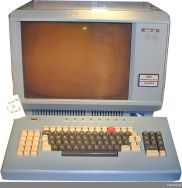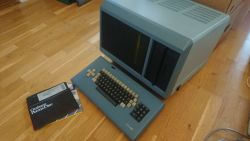Tandberg Data TDV 2100 Series
This article is a stub. You can help Deskthority by expanding it.
The Tandberg Data TDV-2100 series was a series of terminals and microcomputers originally developed by electronics-giant Tandberg Radiofrabrikk in 1976. Noteworthy examples included the TDV-2114 microcomputer and the TDV-2115 terminal, as well as customized versions for customers such as Norsk Data. Products in the TDV-2100 series were made with different keyboards, for instance older keyboards have high-profile reed switches from C.P. Clare Int., while later manufactured keyboards (used with most terminal-only products in the series) would be based around a Foam and Foil board from Key Tronic.
From a design standpoint, the overall look and feel of the TDV-2100 series is heavily based on the earlier TDV-2000 terminal. Notable differences is that the chassis has been more refined, with strikingly coloured paint and a custom mold-cast front-case having rounded courners. This makes the product look more distinctive and less like a prototype. Devices have been observed in either orange and cream, or dark and light pastel blue.
As products in this series was already well in swing before the time of Tandberg Radiofrabrikk's big bankruptcy in the end of 1978, key-customer Siemens decided to buy out the Tandberg Computer division during the liquidation. This eventually formed the subsidiary Tandberg Data A/S in the process. This was done in a way ensuring no halt in production, and after the liquidation process was done Tandberg Data kept on where Tandberg Radiofrabrikk left with mostly the same employees.
Microcomputers[edit | edit source]
The TDV-2100 series was one of two times Tandberg Data designed a microcomputer from scratch, as well as being their only computer based on a modular-backplane expansion-card system. Different machines could come with different expansion card sets depending on the customers need, but some cards were standard among all machines in the series. The TDV-2100 series computer lineup can broadly be divided into two groups, the TDV-2114 (1976) and the TDV-2124 (1980). Both of these were marketed as an intelligent terminal with a 12" screen.
Hardware[edit | edit source]
At the heart of the system is the dual-card "Display Logic" terminal module. This is the same module used in the TDV-2115L dumb-terminals, driving the screen, keyboard and serial communications. All terminal-related functionality works standalone from the rest of the system, but it does have an interface used by the CPU to communicate directly with the terminal through the backplane.
Another mandatory card is the Intel 8080 CPU module. This comes with 2KB RAM and up to 8KB ROM, where the ROM will in most cases contain a version of the XMON system-monitor. XMON will be able to run directly off the memory on the module itself, but any higher-level operating system will need additional RAM expansion-card modules. The TDV-2114 was originally designed for up to 48K additional RAM, but later revisions of the CPU module expanded this to 54KB max on expansions. An uncommon modification may be done to bring the total RAM up to the full 64KB, and this is needed for CP/M support.
The last mandatory card for a TDV-2114 is floppy disk controller. This is made for 8" Shugart SA-800 type floppy disk drives, and runs on Single-Side Single-Density media. The operating-systems would be provided on floppy-disk, and XMON will automatically try to load this on boot. This module is the main difference between TDV-2114 and TDV-2124, as the card in the latter is made for the Shugart SA-850 drive and as such adds support for Double-Sided Double-Density media. A TDV-2124 can otherwise still operate as a TDV-2114 since single-density support still remains.
Besides this, there are a handful of other expansion modules. This includes a Cluster-network module, Tape-cartridge (TDC-3000) interface module, Synchronous communications module, Loadable display characters module, etc...
Later on, in 1982, the TDV-2324 replaced the TDV-2124. This was a completely new machine, built around the Intel 8085, 64KB RAM default and 8" HDD-support. It retained backwards-compatibility by keeping a special version of XMON as a loadable module in the operating-systems relying on it.
Operating Systems[edit | edit source]
The main operating system of the TDV-2114 was TOS21, a command-line based system with a look and feed based on Intel ISIS-II. It adapts both the disk file-system, as well as command line syntax, but the loadable file-format is that of ISIS-I "fastload" bin files, and the system APIs are completely different. As such, programs written for ISIS-II and TOS21 are not exchangeable, but it is with ease possible to use ISIS for developing programs to be directly transferred to and run on TOS21. Eventually TOS21 would be upgraded to the more flexible TOS-II, along with the introduction of the TDV-2124 and later TDV-2324. TOS-II is mainly based on a unique double-density double-sided disk file-format, but uses a simple device-driver system to support several different disk formats used at the time (including the previously used ISIS-II format and the TDV-2324 hard-disk).
As mentioned, with a 64KB RAM modification the TDV-2114 will be able to support CP/M. This was eventually an option due to customers desire to run WordStar in the early 1980s. However, this came very late in the life-cycle of the machine, and combined with the mod being non-trivial to add, most TDV-2114s observed in collector-hands does not have it installed.
OEM Products[edit | edit source]
After the 1978 Tandberg-bankruptcy and 1979 acquisition of Tandberg Data by Siemens, Siemens started making their own version of the TDV-2114 and eventually TDV-2124. This machine was marketed as the Siemens 6.610. It had a different case-top and keyboard, but would otherwise be identical to the Tandberg-made machines on the inside. The OS run by these were based on TOS21 and TOS-II, but translated to German and released by Siemens under the name BS1M and BS1MP respectively.
Terminals[edit | edit source]
TDV-2115 was a standalone dumb-terminal, with a bigger 16" screen but without much of the expandability of the TDV-2114. It came in two varieties, L for using the logic display module (similar to the TDV-2114 terminal facilities), or C for using the video-controller display board. Eventually there was also a CV version with the controller display board and output for an external composite PAL monitor. Sales-catalogs at the time indicate that the versions based on the controller display board does not support expansion-modules the same way as the version based on the logic display module.
Eventually a TDV-2116 was released, a middle-ground between the TDV-2114 and TDV-2115L. While the TDV-2115L had only the dumb-terminal module, the TDV-2116 added the CPU module and eventually one ROM or RAM expansion module in the same chassis. Most TDV-2115L have unpopulated sockets for these additional modules in their backplane, so it would be possible to upgrade any TDV-2115L to a TDV-2116 by just adding modules. Still, it lacked storage such as tape or floppy disk drive, had a specialized and narrowed-down XMON version, and was only intended as a page-storage terminal.
Pictures[edit | edit source]
-
TDV-2114 "Intelligent Terminal" computer
-
Keyboard layout of the TDV-2114
-
C.P. Clare Int. high profile reed switches of the TDV-2114


